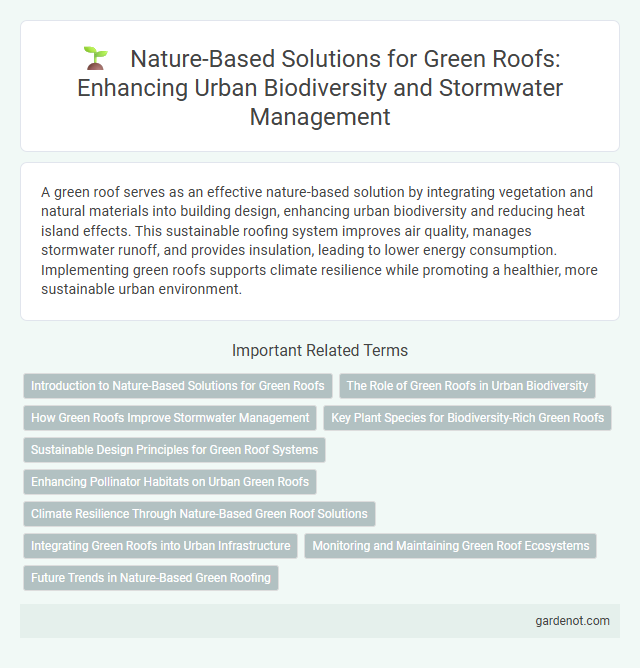A green roof serves as an effective nature-based solution by integrating vegetation and natural materials into building design, enhancing urban biodiversity and reducing heat island effects. This sustainable roofing system improves air quality, manages stormwater runoff, and provides insulation, leading to lower energy consumption. Implementing green roofs supports climate resilience while promoting a healthier, more sustainable urban environment.
Introduction to Nature-Based Solutions for Green Roofs
Nature-based solution roofs integrate vegetation and natural systems to improve urban resilience, enhance biodiversity, and manage stormwater effectively. These green roofs reduce urban heat islands, lower energy consumption, and promote air quality by filtering pollutants. Implementing green roofs as nature-based solutions supports sustainable urban development and climate adaptation strategies.
The Role of Green Roofs in Urban Biodiversity
Green roofs serve as vital nature-based solutions that enhance urban biodiversity by providing habitats for pollinators, birds, and other wildlife within city environments. These engineered ecosystems improve ecological connectivity, supporting native plant species and mitigating habitat fragmentation caused by urban development. By integrating diverse vegetation layers, green roofs promote sustainable urban ecosystems and contribute to the resilience of metropolitan biodiversity networks.
How Green Roofs Improve Stormwater Management
Green roofs act as effective nature-based solutions by absorbing and filtering stormwater through their vegetation and soil layers, significantly reducing runoff volume and peak flow rates. Their porous substrate increases water retention, delaying the discharge into urban drainage systems and mitigating flooding risks. This natural interception process also improves water quality by trapping pollutants, sediments, and heavy metals before water reaches sewer networks.
Key Plant Species for Biodiversity-Rich Green Roofs
Key plant species such as Sedum, native wildflowers, and grasses play a crucial role in creating biodiversity-rich green roofs by providing habitat and food sources for pollinators like bees and butterflies. Incorporating a diverse mix of drought-tolerant and native plants enhances ecological resilience and supports urban wildlife. Selecting species with varying bloom times ensures continuous nectar availability, promoting year-round biodiversity on nature-based solution roofs.
Sustainable Design Principles for Green Roof Systems
Nature-based solution roofs incorporate sustainable design principles by using vegetation layers that enhance urban biodiversity, improve stormwater management, and reduce heat island effects. These systems optimize energy efficiency through natural insulation and promote air quality by filtering pollutants and capturing carbon dioxide. Integrating native plant species and locally sourced materials ensures minimal environmental impact and supports ecosystem resilience.
Enhancing Pollinator Habitats on Urban Green Roofs
Nature-based solution roofs, such as green roofs, play a critical role in enhancing pollinator habitats by providing diverse floral resources and nesting sites for bees, butterflies, and other beneficial insects. Integrating native plant species improves urban biodiversity, supports ecosystem services like pollination, and contributes to climate resilience by mitigating heat island effects. Studies demonstrate that well-designed green roofs increase pollinator abundance and diversity, making them vital components of sustainable urban environments.
Climate Resilience Through Nature-Based Green Roof Solutions
Nature-based green roof solutions enhance urban climate resilience by reducing heat island effects and improving stormwater management. These roofs integrate vegetation layers that absorb rainwater, mitigate flooding, and promote biodiversity within city environments. Implementing green roofs supports carbon sequestration and lowers building energy consumption through natural insulation.
Integrating Green Roofs into Urban Infrastructure
Integrating green roofs into urban infrastructure enhances stormwater management by reducing runoff and mitigating flood risks. These nature-based solutions improve air quality through increased vegetation, which filters pollutants and lowers urban heat island effects. Incorporating green roofs supports biodiversity by providing habitats for native species within densely built environments.
Monitoring and Maintaining Green Roof Ecosystems
Monitoring and maintaining green roof ecosystems is essential for optimizing their environmental benefits, such as improved stormwater management and urban heat island mitigation. Regular assessment of vegetation health, soil moisture levels, and drainage efficiency helps detect stress factors and prevent system failures. Implementing adaptive maintenance strategies ensures sustained biodiversity, structural integrity, and long-term performance of nature-based solution roofs.
Future Trends in Nature-Based Green Roofing
Future trends in nature-based green roofing emphasize the integration of advanced biomimetic materials and smart irrigation technologies to enhance sustainability and energy efficiency. Increasing adoption of modular green roof systems promotes biodiversity by supporting native plant species and urban wildlife habitats. Emerging policies incentivize green roofs as climate adaptation measures, driving widespread implementation in urban planning and real estate development.
Nature-based solution roof Infographic

 gardenot.com
gardenot.com